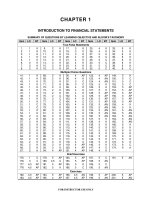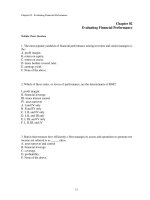Business intelligence and analytics systems for decision support 10th edition sharda test bank
Bạn đang xem bản rút gọn của tài liệu. Xem và tải ngay bản đầy đủ của tài liệu tại đây (302.39 KB, 11 trang )
Business Intelligence and Analytics: Systems for Decision Support, 10e (Sharda)
Chapter 2 Foundations and Technologies for Decision Making
1) When HP approaches problem-solving, the first step in solving business problems is building
a model that enables decision makers to develop a good understanding of the problem.
Answer: FALSE
Diff: 2 Page Ref: 38
2) In a decision making environment, continuous change always validates the assumptions of the
decision makers.
Answer: FALSE
Diff: 1 Page Ref: 40
3) The most important feature of management support systems is the computational efficiency
involved in making a decision.
Answer: FALSE
Diff: 2 Page Ref: 41
4) Web-based decision support systems can provide support to both individuals and groups that
act in a decision-making capacity.
Answer: TRUE
Diff: 1 Page Ref: 42
5) Single decision makers rarely face decisions with multiple objectives in organizations and so
are not the focus of data analytics tools.
Answer: FALSE
Diff: 3 Page Ref: 42
6) The design phase of decision making is where the decision maker examines reality and
identifies and defines the problem.
Answer: FALSE
Diff: 2 Page Ref: 43
7) Only after the failed implementation of a decision can the decision maker return a prior stage
of decision making.
Answer: FALSE
Diff: 3 Page Ref: 43
8) Web-based collaboration tools (e.g., GSS) can assist in multiple stages of decision making,
not just the intelligence phase.
Answer: TRUE
Diff: 2 Page Ref: 44
1
Copyright © 2015 Pearson Education, Inc.
9) Uncovering the existence of a problem can be achieved through monitoring and analyzing of
the organization's productivity level. The derived measurements of productivity are based on real
data.
Answer: TRUE
Diff: 2 Page Ref: 45
10) Qualitative elements of a problem cannot be incorporated into formal decision models, so
one can only seek to minimize their impact.
Answer: FALSE
Diff: 2 Page Ref: 46
11) Since the business environment involves considerable uncertainty, a manager cannot use
modeling to estimate the risks resulting from specific actions.
Answer: FALSE
Diff: 3 Page Ref: 47
12) A normative model examines all the possible alternatives in order to prove that the one
selected is the best.
Answer: TRUE
Diff: 2 Page Ref: 49
13) Since a descriptive model checks the performance of the system for only a subset of all
possible alternatives, there is no guarantee that a selected alternative will be optimal.
Answer: TRUE
Diff: 2 Page Ref: 50-51
14) Generating alternatives manually is often necessary in the model-building process. The best
option for the decision makers is to generate as many of these alternatives as is conceivable.
Answer: FALSE
Diff: 2 Page Ref: 52
15) Generally speaking, people intuitively estimate risk quite accurately.
Answer: FALSE
Diff: 1 Page Ref: 55-56
16) A data warehouse can support the intelligence phase of decision making by continuously
monitoring both internal and external information, looking for early signs of problems and
opportunities through a Web-based enterprise information portal or dashboard.
Answer: TRUE
Diff: 1 Page Ref: 57
17) Business intelligence systems typically support solving a certain problem or evaluate an
opportunity, while decision support systems monitor situations and identify problems and/or
opportunities, using analytic methods.
Answer: FALSE
Diff: 2 Page Ref: 59
2
Copyright © 2015 Pearson Education, Inc.
18) Artificial intelligence-based DSS fall into this category of document-driven DSS.
Answer: FALSE
Diff: 2 Page Ref: 62
19) The DSS component that includes the financial, statistical, management science, or other
quantitative models is called the model management subsystem.
Answer: TRUE
Diff: 2 Page Ref: 66
20) Knowledge-based management subsystems provide intelligence to augment the decision
maker's own intelligence.
Answer: TRUE
Diff: 2 Page Ref: 69
21) The HP Case illustrates that after analytics are chosen to solve a problem, building a new
decision model from scratch or purchasing one may not always be the best approach. Why is
that?
A) Decision models should never be purchased, only developed in house.
B) A related tool requiring slight modification may already exist.
C) CIOs are more likely to allocate funds to new development.
D) Analytic models work better when they are built from scratch or purchased.
Answer: B
Diff: 3 Page Ref: 38
22) Groupthink in a decision-making environment occurs when
A) group members all use the same analytic tools without having a choice.
B) group members accept the same timeframe for problem solving without complaining.
C) group members all accept a course of action without thinking for themselves.
D) group members are all working together for the firm's success.
Answer: C
Diff: 3 Page Ref: 40
23) All of the following statements about decision style are true EXCEPT
A) autocratic styles are authority-based.
B) decision styles are consistent among top managers.
C) heuristic styles can also be democratic.
D) decision styles may vary among lower-level managers.
Answer: B
Diff: 3 Page Ref: 41-42
24) A search for alternatives occurs in which phase of the decision making/action model?
A) the design phase
B) the intelligence phase
C) the choice phase
D) the implementation phase
Answer: A
Diff: 2 Page Ref: 43
3
Copyright © 2015 Pearson Education, Inc.
25) All of the following are benefits of using models for decision support EXCEPT
A) it is easier to manipulate a model than a real system.
B) you can find out probable outcomes of an action before actually taking it.
C) using well-designed models always guarantees you success in implementation.
D) the cost of a model is usually much lower than manipulating the system in implementation.
Answer: C
Diff: 2 Page Ref: 47
26) In the design phase of decision making, selecting a principle of choice or criteria means that
A) if an objective model is used with hard data, all decision makers will make the same choice.
B) risk acceptability is a subjective concept and plays little part in modeling.
C) using well-designed models guarantees you success in real life.
D) optimality is not the only criterion for acceptable solutions.
Answer: D
Diff: 2 Page Ref: 49
27) What form of decision theory assumes that decision makers are rational beings who always
seek to strictly maximize economic goals?
A) the theory of bounded rationality
B) normative decision theory
C) satisficing decision theory
D) human optimal decision theory
Answer: B
Diff: 3 Page Ref: 49
28) When an Accounts Payable department improves their information system resulting in faster
payments to vendors, without the Accounts Receivable Department doing the same, leading to a
cash flow crunch, what can we say happened in decision-theoretic terms?
A) optimization
B) profit minimization
C) suboptimization
D) cash flow problems
Answer: C
Diff: 3 Page Ref: 49-50
29) All of the following statements about risk in decision making are correct EXCEPT
A) all business decisions incorporate an element of risk.
B) decision makers frequently measure risk and uncertainty incorrectly.
C) methodologies are available for handling extreme uncertainty.
D) most decision makers are pessimistic about decision outcomes.
Answer: D
Diff: 3 Page Ref: 53
4
Copyright © 2015 Pearson Education, Inc.
30) The Web can play a significant role in making large amounts of information available to
decision makers. Decision makers must be careful that this glut of information does not
A) increase their enthusiasm for data available on the web.
B) take on the same credibility of internally-generated data.
C) take on the same role as human intuition.
D) detract from the quality and speed of decision making.
Answer: D
Diff: 3 Page Ref: 57
31) All of the following statements about the decision implementation phases are true EXCEPT
A) implementation is every bit as important as the decision itself.
B) employees need only the decisions from the CEO, not the rationale.
C) ERP, CRP, and BPM tools can all help track decision implementation.
D) ES and KMS can help in training and support for decision implementation.
Answer: B
Diff: 3 Page Ref: 58-59
32) For DSS, why are semistructured or unstructured decisions the main focus of support?
A) There are many more unstructured and semistructured decisions than structured in
organizations.
B) MIS staff prefer to work on solving unstructured and semistructured decisions.
C) Unstructured and semistructured decisions are the easiest to solve.
D) They include human judgment, which is incorporated into DSS.
Answer: D
Diff: 3 Page Ref: 59
33) What class of DSS incorporates simulation and optimization?
A) model-driven DSS
B) data-driven DSS
C) communications-driven/Group DSS
D) knowledge-driven DSS
Answer: A
Diff: 3 Page Ref: 62-63
34) When a DSS is built, used successfully and integrated into the company's business processes,
it was most likely built for a(n)
A) recurrent decision.
B) one-off decision.
C) unimportant decision.
D) ambiguous decision.
Answer: A
Diff: 3 Page Ref: 63
5
Copyright © 2015 Pearson Education, Inc.
35) The fact that many organizations share many similar problems means that in sourcing a DSS,
it is often wiser to acquire a(n)
A) ready-made DSS.
B) custom-made DSS.
C) offshored DSS.
D) consultant-developed DSS.
Answer: A
Diff: 2 Page Ref: 63-64
36) The software that manages the DSS database and enables relevant data to be accessed by
DSS application programs is called
A) KWS.
B) ERP.
C) DBMS.
D) CRM.
Answer: C
Diff: 2 Page Ref: 65
37) The model management subsystem provides the system's analytical capabilities and
appropriate software management. Which of the following is NOT an element of the model
management subsystem?
A) model base
B) MBMS
C) DBMS
D) model execution, integration, and command processor
Answer: C
Diff: 2 Page Ref: 66
38) While Microsoft Excel can be an efficient tool for developing a DSS, compared to using a
programming language like C++, a shortcoming of Excel is
A) it cannot be used effectively for small or medium sized problems.
B) Excel is not widely understood compared to a language like C++.
C) it is not widely available for purchase.
D) errors can creep into formulas somewhat easily.
Answer: D
Diff: 2 Page Ref: 67
39) What type of user interface has been recognized as an effective DSS GUI because it is
familiar, user friendly, and a gateway to almost all sources of necessary information and data?
A) ASP.net
B) Web browsers
C) visual basic interfaces
D) mainframe interfaces
Answer: B
Diff: 2 Page Ref: 68
6
Copyright © 2015 Pearson Education, Inc.
40) The user communicates with and commands the DSS through the user interface subsystem.
Researchers assert that some of the unique contributions of DSS are derived from
A) the Web browser.
B) the user being considered part of the system.
C) some DSS user interfaces utilizing natural-language input (i.e., text in a human language).
D) the intensive interaction between the computer and the decision maker.
Answer: D
Diff: 3 Page Ref: 68
41) At two opposite ends of the spectrum are autocratic and ________ decision styles.
Answer: democratic
Diff: 1 Page Ref: 41
42) ________ in decision making involves scanning the environment, either intermittently or
continuously.
Answer: Intelligence
Diff: 2 Page Ref: 44
43) The elevators case study shows that correct problem ________ is important in decisionmaking.
Answer: identification
Diff: 2 Page Ref: 45
44) ________ is the conceptualization of a problem in an attempt to place it in a definable
category, possibly leading to a standard solution approach.
Answer: Problem classification
Diff: 2 Page Ref: 46
45) In creating a normative model, a decision maker examines all the alternatives to prove that
the one selected is indeed the best, and is what the person would normally want. This process is
basically known as ________.
Answer: optimization
Diff: 2 Page Ref: 49
46) A(n) ________ is a typically mathematically based model that describes things as they are or
as they are believed to be.
Answer: descriptive model
Diff: 1 Page Ref: 50
47) A(n) ________ map can help a decision maker sketch out the important qualitative factors
and their causal relationships in a messy decision-making situation.
Answer: cognitive
Diff: 2 Page Ref: 51
7
Copyright © 2015 Pearson Education, Inc.
48) The best decision makers accurately estimate the ________ associated with decision
alternatives to aid their selection.
Answer: risk
Diff: 2 Page Ref: 53
49) The ________ phase involves putting a recommended solution to work, not necessarily
implementing a computer system.
Answer: implementation
Diff: 2 Page Ref: 55
50) Early definitions of a(n) ________ identified it as a system intended to support managerial
decision makers in semistructured and unstructured decision situations.
Answer: decision support system (DSS)
Diff: 2 Page Ref: 59
51) DSS applications have been classified in several different ways. ________-driven DSS rely
on knowledge coding, analysis, search, and retrieval for decision support.
Answer: Document
Diff: 3 Page Ref: 62
52) DSS developed around optimization or simulation models and incorporate model
formulation, maintenance, and management in distributed computing environments, are known
as ________-driven DSS.
Answer: model
Diff: 2 Page Ref: 62-63
53) A DSS application can employ a data management subsystem, a model management
subsystem, a user interface subsystem, and a(n) ________.
Answer: knowledge-based management subsystem
Diff: 3 Page Ref: 64
54) The model management subsystem includes financial, statistical, management science, and
other quantitative models that provide the system's analytical capabilities plus appropriate
software management. This software is often called a(n) ________.
Answer: model base management system (MBMS)
Diff: 2 Page Ref: 65-66
55) In the Station Casinos case, the decision support system brought about benefits from being
able to capture, analyze and segment ________.
Answer: customers
Diff: 1 Page Ref: 66
56) Because DSS deal with semistructured or unstructured problems, it is often necessary to
customize models, using programming tools and languages. For small and medium-sized DSS or
for less complex ones, ________ software is usually used.
Answer: spreadsheet
Diff: 2 Page Ref: 67
8
Copyright © 2015 Pearson Education, Inc.
57) The user communicates with and commands the DSS through the ________ subsystem.
Answer: user interface
Diff: 2 Page Ref: 68
58) The knowledge-based management subsystem can be interconnected with the organization's
knowledge repository (part of a knowledge management system [KMS]), which is sometimes
called the ________.
Answer: organizational knowledge base
Diff: 2 Page Ref: 69-70
59) The Watson Question Answering computing platform uses machine ________ to acquire
vast amounts of new medical knowledge.
Answer: learning
Diff: 2 Page Ref: 70
60) Geographical Information Systems (GIS) can be readily integrated with other, more
traditional ________ components and tools for improved decision making.
Answer: decision support system (DSS)
Diff: 2 Page Ref: 72
61) Olavson and Fry (2008) have worked on many spreadsheet models for assisting decision
makers at HP and have identified several lessons from both their successes and their failures
when it comes to constructing and applying spreadsheet-based tools. How do they define a tool?
Answer: They define a tool as "a reusable, analytical solution designed to be handed off to
nontechnical end users to assist them in solving a repeated business problem."
Diff: 3 Page Ref: 38
62) According to Simon (1977), managerial decision making is synonymous with the entire
management process. Give a working definition of decision making.
Answer: Decision making is a process of choosing among two or more alternative courses of
action for the purpose of attaining one or more goals.
Diff: 2 Page Ref: 41
63) Computer support can be provided at a broad level, enabling members of whole departments,
divisions, or even entire organizations to collaborate online. Name some of the various systems
that have evolved from computer support.
Answer: Computer support has evolved over the past few years into enterprise information
systems (EIS) and includes group support systems (GSS), enterprise resource management
(ERM)/enterprise resource planning (ERP), supply chain management (SCM), knowledge
management systems (KMS), and customer relationship management (CRM) systems.
Diff: 2 Page Ref: 42
9
Copyright © 2015 Pearson Education, Inc.
64) Name Simon's four phases of decision making and mention how they are impacted by the
web.
Answer:
• Intelligence
- Access to information to identify problems and opportunities from internal and external data
sources
- Access to analytics methods to identify opportunities
- Collaboration through group support systems (GSS) and knowledge management systems
(KMS)
• Design
- Access to data, models, and solution methods
- Use of online analytical processing (OLAP), data mining, and data warehouses
- Collaboration through GSS and KMS
- Similar solutions available from KMS
• Choice
- Access to methods to evaluate the impacts of proposed solutions
• Implementation
- Web-based collaboration tools (e.g., GSS) and KMS, which can assist in implementing
decisions
- Tools, which monitor the performance of e-commerce and other sites, including intranets,
extranets, and the Internet
Diff: 3 Page Ref: 44
65) A major characteristic of a DSS and many BI tools (notably those of business analytics) is
the inclusion of at least one model. How does the text describe a model?
Answer: A model is a simplified representation or abstraction of reality. It is usually simplified
because reality is too complex to describe exactly and because much of the complexity is
actually irrelevant in solving a specific problem.
Diff: 2 Page Ref: 47
66) According to Simon (1977), most human decision making, whether organizational or
individual, involves a willingness to settle for a satisfactory solution, "something less than the
best." This is called satisficing. How does a decision maker go about satisficing?
Answer: When satisficing, the decision maker sets up an aspiration, a goal, or a desired level of
performance and then searches the alternatives until one is found that achieves this level.
Diff: 2 Page Ref: 51-52
67) A scenario is a statement of assumptions about the operating environment of a particular
system at a given time; that is, it is a narrative description of the decision-situation setting. What
does a scenario describe, and what may it also provide?
Answer: A scenario describes the decision and uncontrollable variables and parameters for a
specific modeling situation. It may also provide the procedures and constraints for the modeling.
Diff: 2 Page Ref: 54
10
Copyright © 2015 Pearson Education, Inc.
68) Relate four specific technologies that support all phases of the decision making process, and
describe what they provide.
Answer: Databases, data marts, and especially data warehouses are important technologies in
supporting all phases of decision making. They provide the data that drive decision making.
Diff: 1 Page Ref: 56
69) A DSS is typically built to support the solution of a certain problem or to evaluate an
opportunity. Describe three key characteristics and capabilities of DSS.
Answer:
1. Support for decision makers, mainly in semistructured and unstructured situations, by
bringing together human judgment and computerized information. Such problems cannot be
solved (or cannot be solved conveniently) by other computerized systems or through use of
standard quantitative methods or tools. Generally, these problems gain structure as the DSS is
developed. Even some structured problems have been solved by DSS.
2. Support for all managerial levels, ranging from top executives to line managers.
3. Support for individuals as well as groups. Less-structured problems often require the
involvement of individuals from different departments and organizational levels or even from
different organizations. DSS support virtual teams through collaborative Web tools. DSS have
been developed to support individual and group work, as well as to support individual decision
making and groups of decision makers working somewhat independently.
4. Support for interdependent and/or sequential decisions. The decisions may be made once,
several times, or repeatedly.
5. Support in all phases of the decision-making process: intelligence, design, choice, and
implementation.
6. Support for a variety of decision-making processes and styles.
7. The decision maker should be reactive, able to confront changing conditions quickly, and
able to adapt the DSS to meet these changes. DSS are flexible, so users can add, delete, combine,
change, or rearrange basic elements. They are also flexible in that they can be readily modified to
solve other, similar problems.
Diff: 3 Page Ref: 60
70) Name and give a brief description of each of the components of a DSS application.
Answer:
• A data management subsystem, which includes a database that contains relevant data for the
situation
• A model management subsystem, which is the component that includes financial, statistical,
management science, or other quantitative models that provide the system's analytical
capabilities and appropriate software management
• A user interface subsystem, through which the user communicates with and commands the
DSS, and which a user is considered a part of
• A knowledge-based management subsystem, which provides intelligence to augment the
decision maker's own.
Diff: 3 Page Ref: 65-70
11
Copyright © 2015 Pearson Education, Inc.









